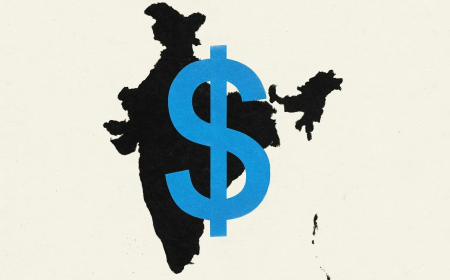Disinflation May Slow Down FPI Inflows into Indian Bonds Despite Index Inclusion
Falling inflation may temper the pace of foreign portfolio investment into Indian bonds, even as India prepares for global index inclusion. Here's what investors should watch.

🇮🇳 Disinflation May Temper FPI Flows into Indian Bonds
India's bond market, long a story of opportunity underscored by strong macro fundamentals and high real yields, is now entering a more complex narrative. With consumer inflation trending lower and expectations of further disinflation building up, foreign portfolio investors (FPIs) may reassess their appetite for Indian government bonds—despite the upcoming milestone of index inclusion in global bond benchmarks like JP Morgan's GBI-EM.
While the long-term outlook remains structurally positive, near-term flows may see a moderation as global fund managers recalibrate their strategies in response to falling yield differentials and slowing inflation momentum.
The Disinflation Trend: A Snapshot
India's Consumer Price Index (CPI) inflation has been on a downward trajectory in recent months. In April, CPI inflation eased to 4.83%, down from 5.09% in March, marking the lowest level in 11 months.
Food prices, a traditionally sticky component, have also begun to show signs of softening, aided by improved supply chain logistics, early arrival of rabi crops, and active government intervention in essential commodities like pulses and onions.
Key data points:
-
Core inflation (excluding food and fuel) dropped to 3.2%, its lowest in over three years.
-
Wholesale inflation remains in deflationary territory at -0.5% YoY.
-
RBI’s inflation projection for FY26 stands at 4.5%, suggesting further downside.
The falling inflation trajectory has important implications—not just for domestic bond yields and monetary policy—but also for foreign investors assessing yield plays across global markets.
FPI Behavior: Chasing Real Yields No Longer?
Foreign portfolio investors are a critical component of India’s capital flows. In FY24, FPIs pumped in over ₹66,000 crore ($8 billion approx.) into the debt market, a sharp contrast to the outflows witnessed in FY23.
One major reason behind the surge? High real interest rates.
With policy repo rates at 6.50% and inflation under control, India offered a compelling positive real rate environment. But as inflation slows, real returns on Indian bonds may start to look less exciting—especially when adjusted for currency and hedging costs.
Consider this:
-
If inflation drops to 4.3% and the RBI keeps rates on hold, real yield stands at ~2.2%
-
In contrast, other EMs like Brazil or Indonesia offer real yields upwards of 4%
-
US Treasuries have become more attractive as inflation softens globally, offering 4.3–4.5% yields risk-free
This shrinking yield differential can moderate the pace of new FPI inflows into Indian debt, even as structural factors remain supportive.
JP Morgan Index Inclusion: Is the Optimism Already Priced In?
India’s upcoming inclusion into the JP Morgan GBI-EM Global Diversified Index, set to begin in June 2024, is projected to bring in $20–25 billion of passive flows over a 10-month phase-in.
The anticipation of this inclusion has been a major driver of bond optimism since the announcement in September 2023. FPIs have already been building exposure to benchmark G-Secs, especially those with longer maturities and higher liquidity.
However, the market is now questioning:
Has most of the inflow been front-loaded?
Will global funds wait and see how inflation and RBI policy evolve before deploying further capital?
While index-linked passive funds are bound to invest based on rebalancing timelines, active global funds may hold off until yield differentials widen again or signs of an RBI rate cut emerge.
RBI’s Dilemma: Stay Hawkish or Accommodate?
The Reserve Bank of India has maintained a “withdrawal of accommodation” stance, balancing inflation concerns with growth priorities. While the central bank has refrained from hiking further, it has also offered no signal of an imminent rate cut.
Key points from the last policy meeting:
-
Inflation remains within target but volatile food prices are a risk
-
Liquidity is tightening in the banking system
-
RBI is monitoring global financial conditions closely
If inflation continues to cool and growth remains resilient, the central bank may find room for policy easing in late 2024 or early 2025. That could reinvigorate FPI interest in longer-duration bonds. Until then, however, the “wait and watch” approach is likely to persist.
Yield Curve Dynamics: Flattening Bias Prevails
Disinflation has also begun to affect the structure of India’s yield curve:
-
The 5-year G-Sec yield has fallen faster than the 10-year, narrowing the spread
-
Market participants are increasingly parking funds in mid-duration bonds, anticipating rate cuts later in the year
-
The flattening curve is also a reflection of reduced term premium, as inflation expectations stay anchored
This flattening could deter foreign funds who traditionally prefer longer-dated, higher-yielding paper—especially for currency-hedged positions.
FPI Inflows in Numbers: Signs of Cooling?
Recent data from NSDL and Clearing Corporation of India Ltd (CCIL) suggests that while FPIs remain net buyers of Indian debt, the pace of investment has slowed.
-
April 2024: ₹11,300 crore net inflow
-
May (first half): ₹4,200 crore (moderation visible)
-
Bulk of inflows directed to 5–10 year maturity G-Secs
This suggests investors are becoming more selective and tactical, focusing on liquidity and yield pick-up rather than indiscriminate buying.
Market Voices: What Fund Managers Are Saying
“There is no doubt that India remains a structural long-term story, but at the margin, disinflation reduces urgency for new FPI entries. Some wait-and-see behavior is natural.”
— Aniruddha Chaudhuri, EM Debt Strategist, HSBC
“We expect the index inclusion to proceed smoothly, but flows will be more spread out than originally assumed. The enthusiasm may be tempered by macro data and Fed policy.”
— Rita Menon, Portfolio Manager, PIMCO
Currency Angle: INR Stability Makes Things Tricky
While a strong rupee generally supports FPI flows by reducing currency risk, it can also reduce the hedging benefit foreign investors earn on their positions.
-
USD/INR has remained in a tight 82.80–83.50 band for much of Q1
-
RBI intervention has kept volatility low
-
With global commodity prices falling, further rupee strength cannot be ruled out
For foreign funds, this adds an additional layer of complexity. If returns from Indian bonds are muted and currency upside is limited, the risk-adjusted returns decline.
What Could Reignite FPI Flows?
To reinvigorate foreign appetite in the debt space, several triggers could emerge:
-
RBI Policy Pivot
If inflation continues to undershoot, a dovish pivot later this year could spark a rally in G-Secs. -
Sharp Fall in US Yields
A decisive rate cut cycle from the Fed could widen the yield differential again. -
Rupee Depreciation
A mild depreciation in INR could improve hedged returns for global investors. -
Enhanced Market Access
Faster implementation of new infrastructure like fully accessible routes (FAR) and improved secondary market liquidity may help.
Strategic Outlook: Don’t Ignore the Bigger Picture
While disinflation might temporarily dampen enthusiasm, it’s important to view this as part of a broader economic cycle. India continues to offer:
-
Political and macroeconomic stability
-
A fast-growing economy with low external vulnerabilities
-
A deepening domestic bond market with global aspirations
Over the medium term, the structural case for FPI participation in Indian debt remains intact. Near-term moderation in flows should be seen as a healthy pause, not a reversal.
Disinflation—A Double-Edged Sword
The decline in inflation is a welcome development for the Indian economy. It helps the common citizen, provides policy space, and brings macro stability. But for bond markets—and specifically for foreign investors—it also presents a challenge.
Lower inflation reduces nominal yields, narrows real rate advantages, and tempers the urgency to chase returns in emerging markets. For India, at the cusp of entering the global bond stage, this might mean a slower runway than initially projected—but it doesn’t change the destination.
As always, data, policy, and global cues will chart the course ahead. For now, the bond market waits—patient, cautious, and focused.
What's Your Reaction?
 Like
0
Like
0
 Dislike
0
Dislike
0
 Love
0
Love
0
 Funny
0
Funny
0
 Angry
0
Angry
0
 Sad
0
Sad
0
 Wow
0
Wow
0












































































